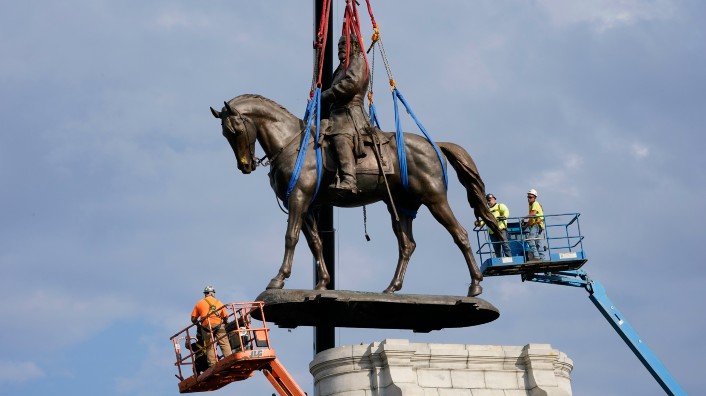SPLC launches third edition of ‘Whose Heritage?’ project tracking removal of Confederate memorials
The SPLC has led in the efforts of removing, renaming, and relocating more than 377 Confederate symbols from the public space since 2015
The Southern Poverty Law Center has been part of the efforts to remove Confederate memorials and symbols in public spaces across the United States and its territories. It’s a resolve that has yielded the removal, relocation, and renaming of more than 377 symbols since 2015, but the work remains as more than 2,000 still exist.
SPLC began their Whose Heritage? project to identify Confederate memorials following the murders of nine Black worshippers at Mother Emanuel AME Church in Charleston, South Carolina in 2015. Dylann Roof, a white supremacist who was convicted of the murders in 2017, was previously seen with Confederate memorabilia.

SPLC held a briefing on Tuesday, the first day of Black History Month, to launch the third edition of their Whose Heritage? project. The report provided data, a map that will allow users to see the location of Confederate memorials across the United States and its territories, and a guide. The organization underscored the harm, hate, and violence these symbols fomented rather than southern heritage.
“Memorials are most often removed in the wake of a tragedy, as we saw after the Charleston Church massacre in 2015; after Heather Heyer’s death at the Unite the Right Rally in 2017; and after George Floyd’s murder in 2020,” SPLC Chief of Staff Lecia Brooks said in a statement.
“But in 2021, Americans continued pushing for change and succeeded by removing a record 73 memorials from public spaces. This is the most symbols affected without a tragedy occurring since SPLC started tracking in 2015, and the second highest number of removals in one year since we began tracking.”

The murder of George Floyd gave SPLC’s movement even more urgency. In 2020, statues of Gen. Robert E. Lee and others came down and were removed from courthouses. The progress continued in 2021. Virginia led with the removal of 20 memorials, followed by Texas with 15 and Florida with 7, according to the report. Thirty-three schools were also renamed and closed, with Virginia once again leading the way with 13.
Rep. Adriano Espaillat (D-NY) co-sponsored the No Funding for Confederate Symbols Act, legislation that would bar federal funds from being used to “to create, maintain, or display, as applicable, any Confederate symbol on Federal public land, including any highway, park, subway, Federal building, military base, street, or other Federal property.” He pledged his continued support during the briefing.
Despite the progress that has been made in removing the dehumanizing memorials, there have been challenges. Many states have enforced draconian preservation laws that stop the removal of Confederate memorials in public spaces. These memorials aren’t just limited to the south, but can be found in Washington D.C. (44), border states (102), those that did not participate in the Civil War (30), and Puerto Rico (1).
SPLC is also encountering the physical representation of the Confederacy and the influence of their presence on military bases, holidays, and municipalities that venerate these racist ideals and those who espoused them. Their research found that Lee, Jefferson Davis, and Stonewall Jackson were the most honored. Lee had 235 memorials, Davis had 144, and Jackson had 121.

This is overlapped by those who are taking Confederate symbols to reflect different means of intimidating Black communities. SPLC punctuated their desire that their efforts are not to erase history but make it a more inclusive space for all.
“Another important supplement to the third edition of the Whose Heritage? report is that we have expanded our tracking beyond public space. The general public frequently interacts with these symbols of hate in cemeteries, federally-funded battlefields, private schools, museums, parks, and even churches. Just like the memorials that occupy public space, their inscriptions promote lies that tout the honoree as a hero. The truth is these men fought to enslave an entire race of Black Americans for personal gain and profit,” Brooks said in the release.
“It is the SPLC’s hope that our Whose Heritage? database and map continue to encourage Americans to work towards removing symbols of hate not only as a reaction to a tragedy, but because Confederate memorials venerate the white supremacist values of the Confederacy and have no place in public space.”
For more information about the Whose Heritage? project, visit here.
Have you subscribed to the Grio podcasts, ‘Dear Culture’ or Acting Up? Download our newest episodes now!
TheGrio is now on Apple TV, Amazon Fire, and Roku. Download theGrio today!
More About:Politics



